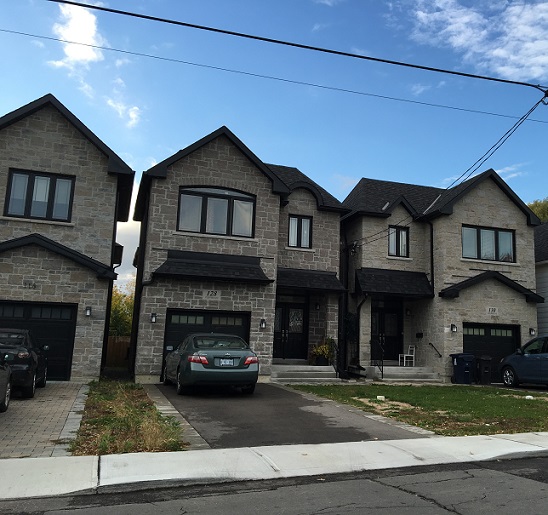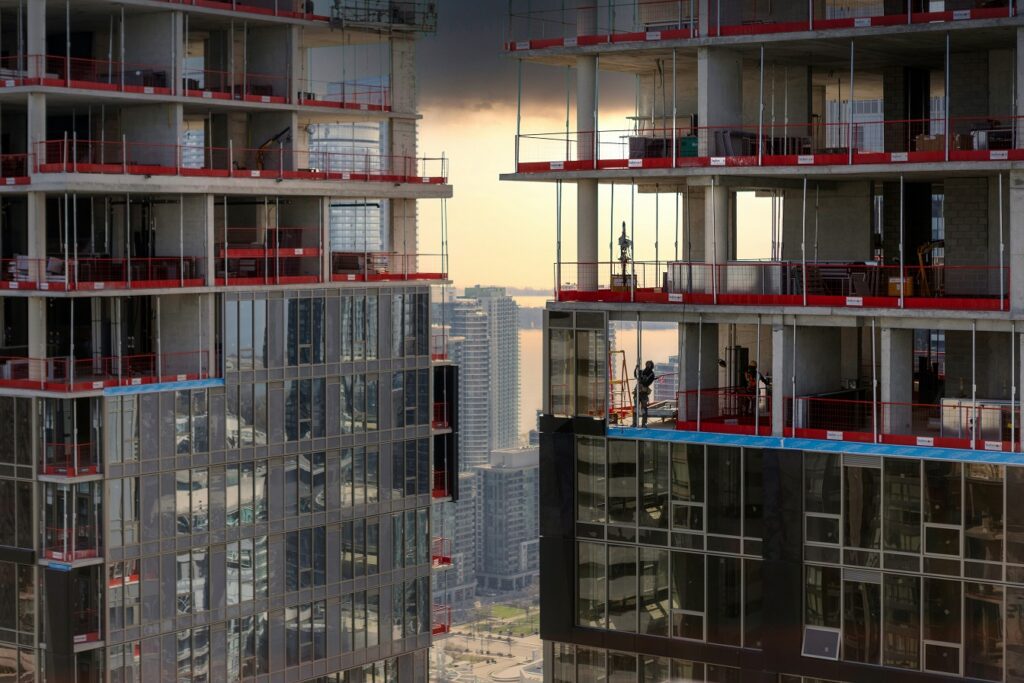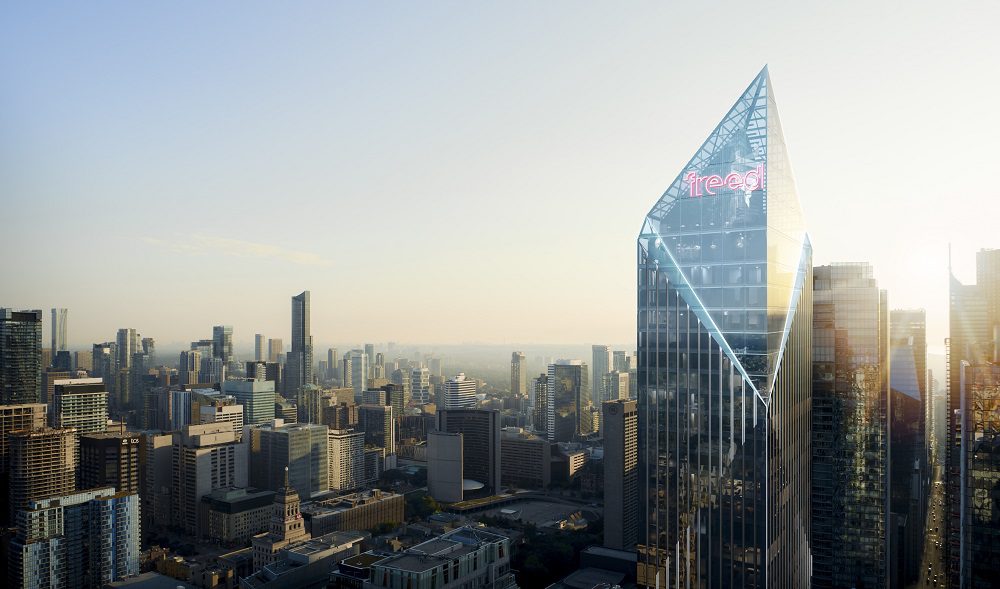I’ve said this before, time and time again: the reason real estate prices are so high in Toronto is because demand massively outpaces supply.
And when we talk about the overall “supply,” we mean those houses that area available for sale.
But what about simply the overall number of houses in existence?
That number isn’t increasing. The “housing completions” are about 99.9% condos.
So when we do see a true “new” house built, it’s usually something like this…

Define “new.”
If you tear down an existing house, and build a “new” house in its place, then technically the house is new, but there are no “new” homes to add to the overall stock of homes in Toronto.
We don’t live in a city where you can simply build 2,000 new homes on a vacant plot of land.
Part of the reason why so many real estate bubbles have crashed around the world is because of the available supply of raw land on which developers can continue to add to the stock of homes.
In Toronto, we almost never add true, new homes.
Drive along Queen Street East in Leslieville, and you’ll see a few old auto body shops in between the upscale meat, cheese, and coffee establishments. Those auto body shops will undoubtedly be turned into small rows of infill townhouses one day. There’s already one being advertised at Queen & Logan.
But how do we create “new” freehold, detached homes?
It’s next to impossible.
And when we do create a new home, it’s often the method shown above.
ONE house at a time.
That’s how slowly we’re increasing our housing stock in Toronto.
But we don’t want to build on parts of The Greenbelt right? Yeah, thought not. Just checking back to see if anybody changed their mind over the weekend…
But for every “new” person who comes to live in Toronto, is there a “new” house built?
No. Not even close.
I would guess that net migration is at least double housing completions, each and ever year, and thus we have far more demand than supply, and that means prices increase.
And when it comes to houses – actual freehold properties, the number of “new” ones will continue to dwindle each and every year. And who knows, maybe in 50 years, only the city’s true elite will live in them…































moonbeam!
at 7:44 am
Two houses in place of one house on a wide lot — means a slight increase in houses available. This is the trend in residential areas of Scarborough. But not everywhere in the GTA. In North York, single monster homes are still replacing bungalows.
By the way, nice to see my street being featured on TRB! Scarborough is a well-kept secret for nice neighbourhoods!
Libertarian
at 11:44 am
Is that your porch that David walked on in the first video? I’ve been a reader of David’d blog for long enough to know that you’re his mom.
I was going to tease David about trespassing on someone’s property to get that close up of the footings, so if it is your house, that explains it.
moonbeam!
at 3:12 pm
Yes David was not trespassing! Shout-out to Mom in Scarborough!
Condodweller
at 8:27 am
Two for one makes sense, though how often do these double lots come up for sale? I think they are mostly estate sales or downsizers selling one at a time. It’s not like a large builder can go and buy 50000 double lots and turn them into 100000 houses to meet immigration growth. Do we know how many double lots exist currently in the GTA?
Regarding the green belt it is a mythical creature to me. Where is and what is it? When I drive north either on Yonge St., 400 or 404 I see building happening everywhere. Perhaps I have to go further north. But more importantly, what is it and what is it used for currently? Farm land, marsh land, virgin forest, provincial parks? When I look at the map it’s a huge area. Before anyone makes a decision to build in this area it’s prudent to find out what the plan is. If, for example, the reason is to have enough trees to provide enough oxygen for future population of the GTA then it’s probably best not to build on it. If the reasons are somewhat arbitrary or dubious then by all means allocate some. The trouble with these things is once you start it’s a slippery slope. First we take 5% then 10% and before you know it’s gone.
Environmentalists no doubt will say don’t touch it, the real estate industry will no doubt say bulldoze the whole thing but I suspect the answer lies somewhere in between. This brings up the question of how much supply would say 5% of the green belt provide? Would we get 100000 houses from 5% or 500000 or 2 million? The answer to that question would be interesting to know.
Finally, we keep hearing that the supply is too low and we need to deal with that side of the equation. Being the devil’s advocate, why can’t we deal with the demand? I know this is opening Pandora’s box but I’m going to throw it out there. Why can’t we cut back or mostly eliminate immigration? I have my own ideas but wonder what others think.
Real estate millennial
at 10:21 am
There’s absolutely no! reason to go into the green belt because those are areas that most people aren’t willing to commute from. The public transit transportation infrastructure is not in place to service those areas (Milton, George Town, Bolton, north Oshawa and Ajax,). Those all area that reside just before the green belt and there is a lot of places to add supply but if you work downtown Toronto do you want a 2-3 hour daily commute? The problem is in the demand and our expectations of the city and what we believe we are entitled to. Homeownership specifically is a Privilege not a given right.
Kyle
at 12:12 pm
Great point, there is a massive fixation and preoccupation in this city with affordability and detached housing. People need to wake up to the reality that in a large city those two things are and should be mutually exclusive.
People need to either adjust expectations or be willing to pay the real costs, creating sub-1M detached houses 1-1.5 hours away only forces everyone else to subsidize that person’s unrealistic housing expectations, through increased congestion, pollution and the infrastructure costs.
Jack
at 2:47 pm
If you reduce immigration, the housing problem will get worse, not better. More likely than not, the house you live in was built by immigrants. New construction in the city would slow down without immigrant labour. Just visit any construction site to see for yourself.
downtown
at 11:24 am
I see 2 houses going up on 1 lot very often in my neighborhood (south Annex). They’re not double lots. Just cramming 2 tiny houses where a small house used to be. It increases density (which I think is good), but doesn’t seem to do much for affordability, since they seem to cost >$1m each. The other popular infill options seem to be old schools and old churches. Sometimes it’s a boutique conversion, other times the old school/church is razed and replaced with townhomes or condo. My only complaint with those is that 3 bedroom units are like hens teeth. You can get a 3 bedroom house, but not a 3 bedroom townhouse or condo downtown, with a few rare exceptions.
IzzyBedibida
at 9:20 am
This is exactly the problem. Families want/need a three bedroom house. None of what is being built is family friendly, or be easy to sell in the future to other families or seniors/downsizers as these designs are not suitable for these groups. Why is this being allowed in the first place?
I spent a few weeks in Amsterdam recently where condo and town home living is the norm. Condos are designed to be family friendly, as are most town home designs. I saw nothing resembling the cramped awkward designs that developers are allowed to pass off here.
Longtime lurker
at 8:08 pm
There is one developer who keeps converting a single home to 2 units. The problem is that they have converted them to condos. A condo board with 2 owners is asking for problems. The bedrooms are great but the 1st floor is too compact for a family. The most recent version I saw had the kitchen island as the dining table with a condo sofa in the living room with a couple of chairs. The backyards are also hilarious. They are only useful for bowling or slip and slide. The prices are similar to other semi-detached homes in a neighbourhood closeby so I’m not sure why people wouldn’t buy the semi-detached. The developer is making a very good profit on these projects. The last project converted one house to 3 units for over 1M each! Unfortunately these projects aim to maximize profits versus thinking how people live.
Kyle
at 2:00 pm
These 2 unit condos you speak of are being developed by the Saskin family, same family behind Urbancorp – the infamous, crooked, now bankrupt company. I wouldn’t touch one of these with a ten foot pole.
https://www.thestar.com/news/gta/2015/10/02/downtown-residents-irked-by-dominating-duplex-mega-dwellings.html
Ralph Cramdown
at 9:28 am
“I would guess that net migration is at least double housing completions, each and ever year, and thus we have far more demand than supply, and that means prices increase.”
Howzat? Where are all these extra people living? Household size isn’t increasing so they’re not couch surfing. Living rough in the Don Valley? Moving into large numbers of new, illegal (i.e. no building permit, so uncounted) basement apartments? I think there’s a logic error.
Kyle
at 7:06 am
You’re assuming every residence has residents. In a balanced market supply should be a bit ahead of demand. There’s usually a few months of inventory of homes available for sale and a pipeline of new homes coming on stream. Thus far it is largely this reserve of available housing that has been absorbing the growth in households. But the inventory has pretty much dried up and there’s not much in builders pipes that hasn’t already been sold, so this could be the tipping point to even higher prices.
Kyle
at 11:49 am
Toronto has one of the longest commuting times in North America, so opening the greenbelt isn’t the answer to the supply problem. I see far more possibilities for housing people by simply changing our antiquated zoning by-laws, which currently discourage intensification and encourage greater distances between where a person lives and where that person works and shops. I get that once upon a time you didn’t want to mix industrial lands with residential lands, but what we have now makes zero sense in a large Global city. There are huge swaths of this city, which can only be used for laughably low density residential (i.e. 60% lot coverage), some smaller swaths that can only be used for commercial, and some teeny tiny swaths where residential and commercial can mix on some rigid prescribed basis. Anything that tries to break this mould gets fought tooth and nail by NIMBYs and the City Councillors who turn planning into campaigning. This farce ends up wasting tax payers money and delaying any sort of real progress, and then ultimately gets decided at the OMB anyway. This is the real reason for the supply problems. In any other major city there would be three 3-storey brownstones, terrace houses or townhomes on those 50′ lot.
Then the way th
This is what’s causing the real supply problem.
Greenbelt Troll
at 12:44 pm
David, you’re a downtown city boy, so I’m not sure you understand what or where the greenbelt is. Given that the weather is unseasonably warm this week, I recommend that sometime in the next few days you wake up extra early and drive out to the greenbelt before dawn. Watch the sun come up and take in the spectacular fall colours.
You will be struck by the natural beauty of the area.
Then, drive back to your job in downtown Toronto in the morning rush.
You will be struck by i) HOW FRIGGING FAR THE GREENBELT IS and ii) how grossly inadequate the GTA’s transit infrastructure is to make actually living there if it were opened up a realistic proposition.
There are still a lot of areas before the greenbelt that have not and are not (in the near future) being built up because of infrastructure problems (transit, but also water/sewage) — opening the greenbelt to construction really will not solve that supply problem.
Natrx
at 1:25 pm
Going to have to do it like most of the world.. live with your parents and have your kids there. Multi-generational housing.
Kyle
at 2:34 pm
Has anyone ever seen this?
http://www1.toronto.ca/wps/portal/contentonly?vgnextoid=6dac3f8a7d6c1410VgnVCM10000071d60f89RCRD&vgnextchannel=75461ba53b450410VgnVCM10000071d60f89RCRD
It reads like a how to design a suburban enclave guide. It’s ridiculous and embarrassing that this is the official zoning for the core of a large city. And ironically much of the old housing stock would today be considered too dense and be in violation of these zoning rules. This is the real reason behind our supply issues. The problem isn’t that there isn’t enough land to build on, the problem is you’re not allowed to build the type of housing that belongs in the middle of a large city.
If you really want to intensify and solve the affordability issues, simply eliminate the one house per lot rule and increase the allowable coverage and poof supply issues solved.
Kyle
at 9:22 am
Interesting map and discussion on the subject here:
https://twitter.com/PlannerSean/status/792909043450912768
Kramer
at 1:10 am
Many key figures have said supply is the issue in Toronto.
Lack of supply as cause for price increase cannot lead to a “bubble”.
The only thing that can cause serious strife is significant increase in interest rates, attacking demand side.
Government has imposed new rules to further protect near term buyers from such potential strife.
Banks have already been requiring variable rate mortgage buyers to qualify at 5-year fixed rate.
Now that 5-year fixed rate is near variable rate, they are requiring 5-year fixed rate buyers to qualify at higher rate.
Foreign buyers loophole closed.
Net: Government trying to even the playing field for all Canadian buyers, both against foreign competition and vs 5-year fixed rates being near historically low variable rate.
Supply issue unchanged.
Market prices will continue to rise but at a more responsible rate for Canadian buyers.
As always regarding Canadian mortgage policy protecting us harsh reactions to “black swan events”, job well done policy makers.
Frances
at 10:43 pm
In my area, northwest from Bathurst and Lawrence, the small homes are being replaced by monster homes on the same lot. Why can’t we replace one house with two on any lot of 50 ft. or more? A 25 ft. lot is common in the old city and the houses seem to be eagerly sought after. Most of the lots here are at least 50 ft wide although my house is on the end of a block and our lot is 45 ft. If we consistently rebuilt that way, we could double the number of houses in large areas of the city.